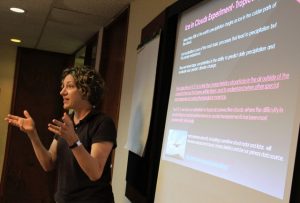CLOUD MICROPHYSICS GROUP

Group Head:
Sonia Lasher-Trapp, Blue Waters Professor
Dept. of Atmospheric Sciences
217-244-4250
slasher@illinois.edu
NEWS
LATEST PUBLICATION
Our most recent published study is entitled: Entrainment in a Simulated Supercell Thunderstorm. Part III: The Influence of Decreased Environmental Humidity and General Effects upon Precipitation Efficiency. J. Atmos. Sci., 80, 1107-1122.
In the third paper of this series, the three distinct mechanisms of entrainment identified during the mature stage of idealized supercell thunderstorms in Part I (overturning “ribbons” of horizontal vorticity, “disorganized turbulent eddies,” and the “storm-relative airstream”) are examined as the absolute humidity of the environment is decreased. The existence of these mechanisms in a more realistic simulated storm environment is also established. Entrainment is calculated as fluxes of air across the storm core surface; passive fluid tracers help determine the resulting dilution of the storm updraft. Model microphysical rates are used to examine the direct impacts of entrainment on hydrometeors within the storm updraft as well as precipitation that falls to the ground. Results show that as mixed-layer humidity decreases, the “ribbons” and turbulent eddy mechanisms decrease in intensity, but their effects on precipitation production change little. With decreasing humidity in the 3–4 km AGL layer, the storm-relative airstream entrains less humid low-level air into the storm core, decreasing the vertical mass flux, and therefore the precipitation produced by the storm. When the humidity in the mid- to upper troposphere (4–20 km AGL) is decreased, precipitation is significantly reduced, but not due to the effects of the entrained air. Rather, enhanced evaporation and sublimation of falling precipitation decreases the overall precipitation efficiency of the storm
What can be seen in the animation above is the discrete “ribbons” of overturning motions introduce air into the core of the thunderstorm. They do not reach all the way into the interior of the core, allowing part of the updraft to still remain unaffected (“undiluted”) by entrainment, as shown and discussed in the paper. This work was supported by an award from NSF: AGS17-25190, and used the Blue Waters Supercomputer, as well as the NSF/NCAR Cheyenne supercomputer, all supported by NSF. The Blue Waters computer was also supported in part by the State of Illinois.
CONGRATULATIONS TO THE NEW GRADUATE!
Group member Holly Mallinson successfully defended her Ph.D. in April 2023. Holly has accepted a postdoc position at NASA-Goddard. The title of her dissertation is HAILFALL IN A FUTURE CLIMATE USING A PSEUDO-GLOBAL WARMING APPROACH. She has two papers in review, and another in prep.
GROUP OVERVIEW
Our group uses numerical modeling with observational analysis to investigate research problems associated with the development of clouds and precipitation. Our successes in the last decade, often with other collaborators, include demonstrating when giant aerosol particles are (or are not) important in warm rain formation, how the productivity of the warm rain process may change in a future warmer climate, the importance of variability resulting from entrainment and mixing upon accelerating or preventing warm rain formation, the influence of a strong warm rain process upon ice production in oceanic cumuli, and the behavior of clouds as shedding thermals that thus entrain air through their leading edges. We have published multiple articles in peer-reviewed journals and regularly present our work at the AMS Cloud Physics Conference and the International Conference on Clouds and Precipitation.
We have also contributed to the development of tools for visualization of ground-based and airborne radar data and high-resolution numerical simulations of clouds, evaluated the performance of aircraft-mounted cloud microphysical probes, and tested microphysical parameterizations in larger-scale cloud models. Finally, we have contributed to science education through studies on improving undergraduate understanding of the nature of science, and the development and evaluation of research-based laboratories for undergraduates in atmospheric science.
OUR FUTURE
We continue to shift our emphasis toward microphysical processes in deep convection. Current projects include using very high-resolution simulations on the NSF/NCAR supercomputer to investigate aerosol effects upon convective outflows and cold pools (DOE- ASR award), studying the possible effects of climate change on severe weather, including hail storms and wind storms (NSF award, Jeff Trapp lead PI), and hail storms in Indonesia.
